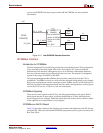
52 www.xilinx.com ML310 User Guide
1-800-255-7778 UG068 (v1.01) August 25, 2004
Chapter 2: ML310 Embedded Development Platform
R
Table 2-23 lists the IIC devices and their associated addresses.
Serial Peripheral Interface (SPI)
Introduction to SPI
Serial Peripheral Interface™ (SPI), is a serial interface much like the IIC Bus interface.
There are three primary differences; the SPI operates at a higher speed, there are separate
transmit and receive data lines, and the device access is chip-select based instead of
address based. The EDK kit provides IP that integrates the SPI interface with a
microprocessor system, please review the EDK Processor IP reference Guide for more details.
SPI Signaling
There are four main signals used in the SPI™ interface; Clock, Data In, Data Out, and Chip
Select. Signaling rates on the SPI bus range from 1 MHz to 3MHz, roughly a factor of 10
faster than the IIC bus interface. SPI continues to differ from IIC using active drivers for
driving the signal high and low, while IIC only actively drives signals low, relying on a
pull-up resistor to pull the signal high.
There are four basic signals on the SPI bus:
• Master Out Slave In (MOSI) is a data line that supplies the output data from the
master device that is shifted into a slave device
• Master In Slave Out (MISO) is a data line that supplies the output data from a slave
device that is shifted into the master device
• Serial Clock (SCK) is a control line driven by the master device to regulate the flow of
data and enable a master to transmit data at a variety of baud rates
♦ The SCK line must cycle once for each data bit that is transmitted
• Slave Select (SS) is a control line to dedicated to a specific slave device that allows the
master device to turn the slave device on and off
Table 2-23: IIC Devices and Addresses
Device
Reference
Designator
Address Description
LTC1694 U27 n/a SMBus accelerator that ensures data integrity
with multiple devices on the SMBus. Enhances
data transmission speed and reliability under all
specified SMBus loading conditions and is
compatible with the IIC bus.
RTC8564 U22 0xA2 IIC bus interface real time clock module along
with an external rechargeable battery and
charging circuit.
24LC64 U21 0xA0 EEPROM is a 64 Kb electrically erasable PROM.
LM87 U20 0x5C Voltage/Temperature monitor
* Note: The IIC bus can be controlled directly by the FPGA or indirectly by the ALi bridge over the
FPGA PCI interface.


















